The Trauma Ed Gap: Demand High, Supply Low
Despite increasing interest among journalism educators in teaching trauma preparedness, few courses are offered, according to a new study by San Diego State University journalism professor and 2011 Dart Center Academic Fellow Amy Schmitz Weiss.

The Learning Gap: The Role of Crisis Training in Journalism Classes
By Amy Schmitz Weiss, Ph.D.
2011 Dart Fellow
Associate Professor of Journalism
San Diego State University
(This report was completed in part from a Fellowship that Amy Schmitz Weiss received in 2011 from the Dart Center for Journalism & Trauma)
Click here for a tip sheet for journalism educators.
Traumatic events such as violent crimes, accidents, conflict, war, natural disasters and other difficult situationsi occur often in society. The journalists who cover these traumatic events often become the first responders at the scene alongside medical authorities and government officials. These journalists must act quickly to gather the information and inform the public accordingly. Often, journalists have the training and know-how to do typical newsgathering and reporting in a variety of situations, but do they know how to cover and report on a traumatic news event? Recent work has found that journalists feel ill equipped to know how to handle these kinds of situations both during and after the traumatic event.ii A root cause of this problem may be the result of a lack of education and training on reporting about trauma or crisis events. This lack of training may be tied to their learning experiences at the beginning of the journalist’s career, while they are still in college.
There are some journalism or mass communication programs in the United States that are devoted to trauma training. According to Mark Masseiii, there are few schools that have implemented trauma training in the classroom. Those that have include Michigan State University, University of Washington, University of Central Oklahoma, University of Missouri, Columbia University and Indiana University.
Besides these programs, are there educators in other journalism and mass communication programs who are teaching crisis and trauma training to their students?
In conjunction with the Dart Center, I conducted a study on how journalism educators who teach in mass communication and journalism programs in the United States teach their students how to cover and report on crisis and traumatic events. This article highlights the major findings from that study. Specifically, educators were asked if they were teaching courses in the area of crisis and disasters, what resources and techniques they were using, what kind of Dart resources were they were using in the classroom, and what educational outcomes they observed when teaching this topic.
METHODOLOGY
An online survey was administered to 177 journalism educators in the United States between October and November, 2012. Of the 177 journalism educators identified, 46 emails were bounced-back messages of addresses that no longer existed, for a final sample of 131, with a response rate of 25% (n=33).
NOTE: It is important to note that this study does not generalize to the wider population of journalism educators, but does open the discourse about how this particular sample (n=33) participated in the study.
MAJOR FINDINGS
IMPORTANCE OF TEACHING TRAUMA IN THE CLASSROOM
Journalism educators believe that covering trauma and its effects within a journalistic context is an important topic to cover in the classroom.
All the educators (100%) in the sample stated it was important to teach journalism students about trauma and its effects on society.
Seventy-six percent of educators said it was very important to teach journalism students about interviewing strategies when dealing with sources who have undergone a crisis or traumatic event, 15% said it was important, 6% said somewhat important and 3% said not important at all.

Forty-nine percent of educators said it was important to teach journalism students about coping mechanisms when covering a traumatic event as part of the journalist’s self-care, 33% said very important, 15% said somewhat important and 3% said not important at all.

LACK OF TRAUMA TRAINING
Despite the importance that journalism educators stated previously for teaching this topic in the classroom, most educators surveyed said that their schools and departments do not currently offer classes or workshops to students on this topic.
About 93% said that their department or college did not offer any classes in trauma or crisis training in comparison to 7% who said they did. About 90% said their school or department didn’t offer workshops or short-term educational opportunities on crisis training in comparison to 10% who said they did.
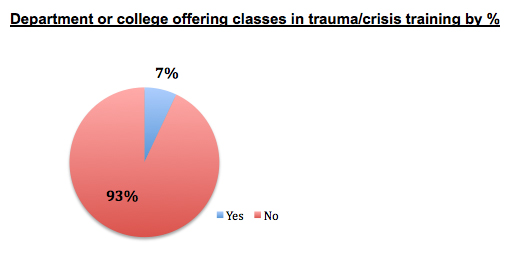
Eighty-eight percent of the respondents said they didn’t teach a course in trauma training in comparison to 12% who said they did. About 57.6% said they didn’t have a session or lecture on the subject in any of their classes in comparison to 42% who said they did.
In addition, 73% of respondents said they would be interested in teaching a course on crisis/trauma training to their journalism students in the future in comparison to 27% who said no.
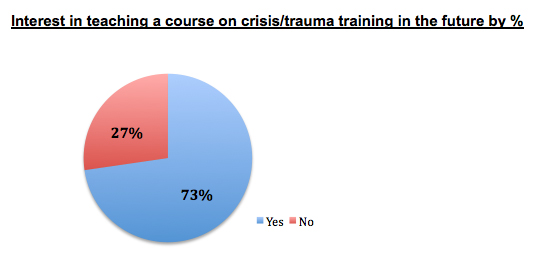
PEDAGOGICAL TECHNIQUES AND RESOURCES USED IN THE CLASSROOM
Of the educators surveyed who said they did teach crisis/trauma training to their students, they stated the use of a variety of pedagogical tools and techniques to scaffold the students’ learning. The most popular resources included online readings, videos, and presentations. The most popular techniques used by these educators included discussion forums, case studies and role-play.
Of those who said they did teach crisis/trauma training to their students (either as a lecture or full class) reported using various pedagogical methods in the classroom including news stories (24%), case studies (15%), discussion forums (12%), role-play (9%), and reflection papers or essays (9%). Other educators stated using reporting exercises (6%), multimedia stories (6%), tests/exams (6%), social media (6%), writing exercises (3%), blogs (3%) and quizzes (3%).
[SEE TABLE 1 BELOW]
Of the respondents who said they did teach crisis/trauma training to their students (either as a full class or a lecture), they reported using a variety of resources to help teach the topic including videos (24%), PowerPoint presentations (24%), readings from the web (21%), textbooks (15%), photos (15%) and social media (6%).
[SEE TABLE 2 BELOW]
DART RESOURCES USED IN THE CLASSROOM
About 55% of journalism educators have not used Dart resources when teaching trauma in the classroom. Of the 45% who have, they cite use of articles, videos and tipsheets from the Dart Center website.
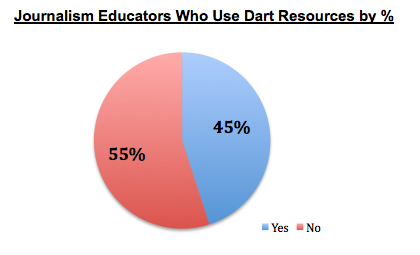
Of those who have used Dart resources, journalism educators listed the following items: Covering Columbine, How News is Framed, Covering Trauma, articles, Dart Center DVD, research reports, sexual violence section for domestic violence cases, videos dealing with rape victims and the family of murder victims, tipsheets on trauma, Covering War and Traumatic events brochures, among others.
EDUCATIONAL OUTCOMES ACHIEVED IN TEACHING TRAUMA TRAINING IN THE CLASSROOM
Of the educators who responded that they teach trauma training to their students, they stated a variety of outcomes for their students. Some said it helped their students become better reporters and interviewers for stories in general and when covering crisis or traumatic events.
One educator stated, “Students seem to acquire a greater sensitivity toward interviewees, whether those people have suffered from some sort of trauma or not.”
Another educator said that the trauma training helped the students to have a better understanding of the issues that reporters face when reporting on traumatic stories or events.
Two educators highlighted the importance of awareness as a learning outcome. They found the students became more aware of the public and themselves when covering a catastrophic event.
One educator stated, “In general I think the main outcome is that students are more aware of what are vulnerable populations and the consequences of exposing them.” Another educator said, “It seems to me that awareness was the greatest outcome. Students reported that it had never occurred to them that covering trauma could affect them as journalists. They also had not thought about how they could affect those already in trauma other than not wanting to bother them.”
DEMOGRAPHICS OF THE SAMPLE
The average age of the respondents was 50 years old. Ninety-one percent were former journalists. Ninety percent stated that they didn’t receive crisis and trauma training when they were working as a journalist in the field. On average, most of the respondents worked in the journalism industry for about 13 years. Fifty-two percent of respondents were female and 48 percent were male. A majority (75.8%) of the respondents were from schools of journalism or communication. About 33% were assistant professors, 27% were associate professors, 27% were full professors, 9% were adjunct faculty and 3% were other.

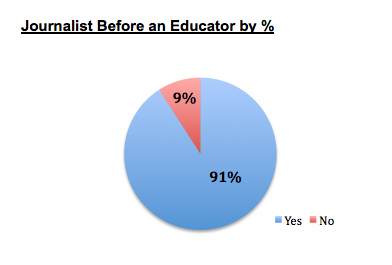
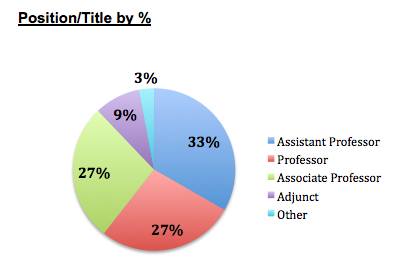
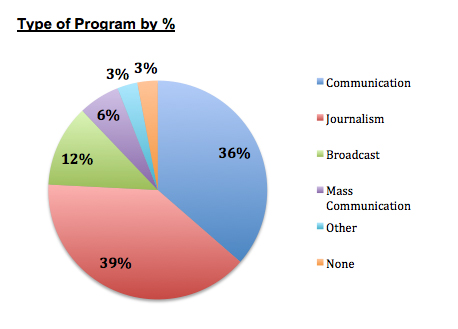
CONCLUSION
In conclusion, based on the sample of educators who responded to the survey, few of them are teaching the subject of trauma and crisis to their students and how to report on it. Yet, a majority of the educators surveyed said they would be interested in teaching the subject in the future.
It is important to note that this study does not generalize to the wider population of journalism educators, but does open the discourse about how this particular sample participated in the study.
This study brings to light the potential gap in what the educators are doing and what they would like to do with their journalism students in the classroom in relation to crisis and trauma training.
Journalism educators have an impact on journalism students in how they learn, what they learn and how they apply those skills and techniques once they graduate and enter the workforce. Journalism students of today, who are the future journalists of tomorrow, inherit a great responsibility to cover to cover their communities especially in the moments of a crisis, hazard or disaster. Arming journalism students with the necessary information, skills and techniques in this area can better equip them to handle any future traumatic event that they encounter.
This study also highlights the lack of continual training in the profession. The majority of the journalism educators surveyed said that when they were working in journalism, they never received crisis or trauma training at their workplace. As noted earlier, journalists have spoken out about this issue and their want for more training in this area among early, mid-career and late-career professionals.iv
Journalists who are currently working in newsrooms today can become the mentors, editors or colleagues of the graduating journalism students of tomorrow who enter the workforce. Today’s journalists who lack the expertise in covering a traumatic event can become a detriment to the young journalist of tomorrow if the mentor or editor is not aware of what to do in moments of crisis to best guide the young professional.
This study highlights how journalism and mass communication programs may need to consider the role of trauma training in their overall curricula and how it can fit into their programs. This is not a new finding as other scholars exploring this topic have brought it up in past studies.v
This study has implications for the students who are going through journalism and mass communication programs today. The media helps to define disasters that occur, how they are documented and understood in society.vi It’s worth noting that journalism educators have a role to play in helping journalism students understand the responsibility that they will have when they enter the newsroom after graduation, especially in covering the crises, disasters and hazards that may hit their towns. Journalism educators have the opportunity to make sure they provide as much information and techniques as possible to journalism students so they can apply what they have learned to cover crises and disasters responsibly, accurately and humanely when they graduate:
"By informing students of the effects of trauma journalism, we educators will help prepare them for what they will encounter, and hopefully, enable them toe be more resilient, responsible, and effective as news media professionals." vii
Yet, it has to be said that journalism and mass communication programs cannot just change curricula instantly to accommodate the newest or latest skills or techniques that journalism students need. Incorporating trauma training in the classroom is complicated as Mark Masse states:
"Modifying existing university journalism curriculum is no easy task, as many academics could attest. Challenges, such as the detailed course-hour requirements facing accredited academic programs, become potential roadblocks for those seeking to add trauma journalism instruction at their institution. Such realities would help to explain why there are only a handful of designated trauma classes in journalism programs in the United States and other countries." viii
This study highlights an incongruity between educators and the programs they work in. The divide may be due not to a lack of interest in offering trauma education but the challenge of getting it into the curriculum, as Masse points out. This raises the question of the need for a bigger discussion, forum or discourse that could be held at a journalism education convention, conference, colloquium or other gathering where this could be discussed among many journalism educators and key stakeholders.


Notes:
i Dart Center for Journalism and Trauma. Dart Center, accessed from http//www.dartcenter.org
ii Nieman Reports. “Trauma in the aftermath,” Nieman Reports. Accessed from: http://www.nieman.harvard.edu/reports/issue/100059/Winter-2009.aspx ; DartCenter.org; Gretchen Dworznik and Max Grubb, “Preparing for the worst: Making a case for trauma training in the journalism classroom,” Journalism and Mass Communication Educator (2007):190-210; Pantti, Wahl-Jorgensen and Cottle, Disasters and the media;Mark H. Masse, Trauma Journalism, On Deadline in Harm’s Way (NY: Continuum International Publishing Group, 2011).
iii Mark H. Masse, Trauma Journalism, On Deadline in Harm’s Way (NY: Continuum International Publishing Group, 2011).
iv Nieman Reports. “Trauma in the aftermath,” Nieman Reports. Accesssed from: http://www.nieman.harvard.edu/reports/issue/100059/Winter-2009.aspx
v Wright, “Mock disaster drill yields challenging reporting exercise;” Maxon, “Training journalism students to deal with trauma;” Ringer Lepre and Luther, “The incorporation of terrorism coverage in academic journalism programs;”Dworznik and Grubb, “Preparing for the worst: Making a case for trauma training in the journalism classroom.”
vi Dworznik and Max Grubb, “Preparing for the worst: Making a case for trauma training in the journalism classroom,” 204; Pantti, Wahl-Jorgensen & Cottle, 2012, p. 200.
vii Masse, Trauma Journalism, On Deadline in Harm’s Way, 175.
viii Masse, Trauma Journalism, On Deadline in Harm’s Way, 170.

































































































